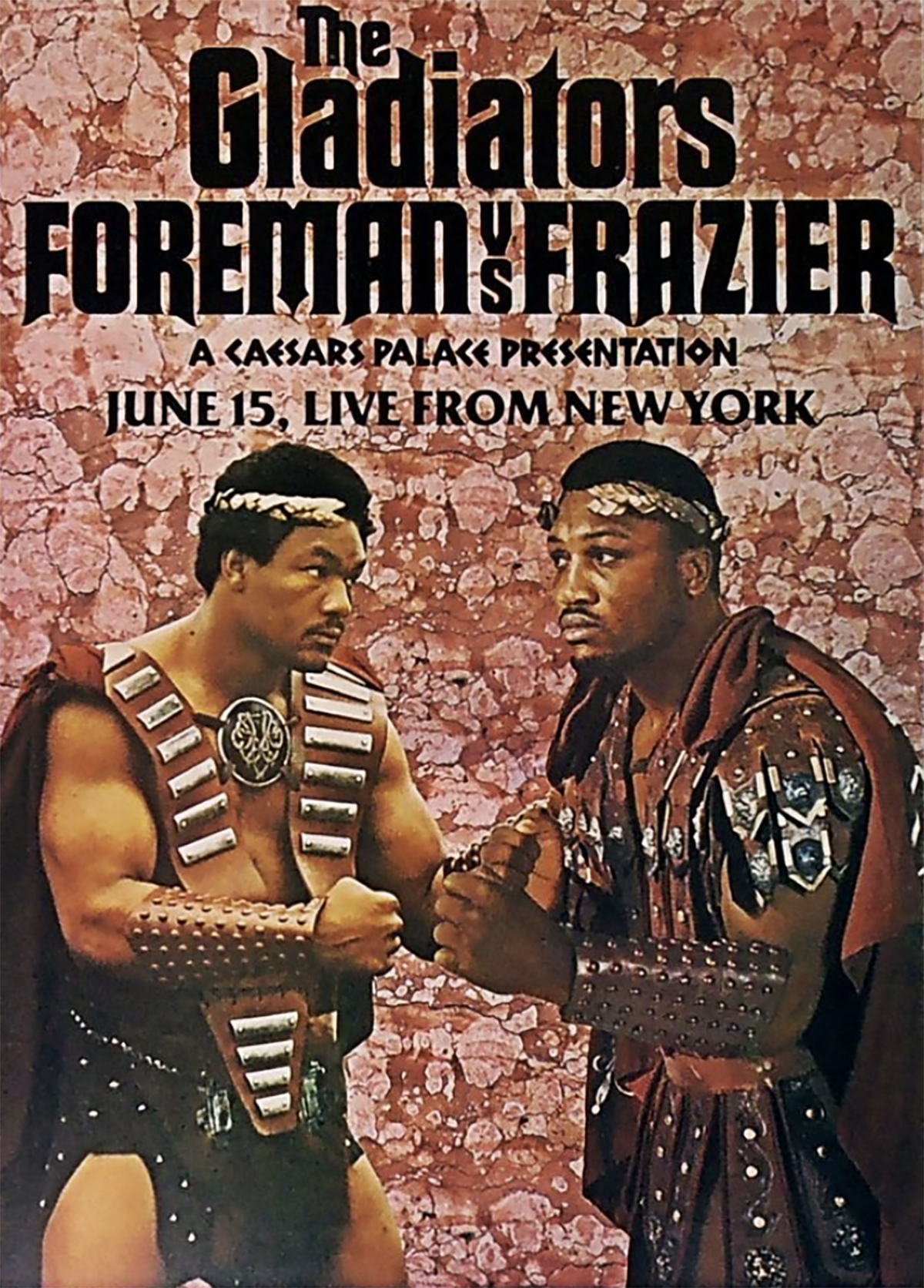The boxing world mourned the loss of a true legend last month with the passing of George Foreman on March 21, 2025, at the age of 76. Beyond his thunderous punches and two storied reigns as heavyweight champion, Foreman’s life was a testament to resilience and reinvention.
As we reflect on his remarkable career, one chapter stands out for Long Islanders more than any other: his second encounter with Joe Frazier in Uniondale, New York, in 1976.
The “Battle of the Gladiators” on Long Island wasn’t just a fight; it was a pivotal moment in Foreman’s journey back to the top, a story of determination etched against the backdrop of a Long Island night.
The year was 1976. America was still processing the end of the Vietnam War, bell-bottoms were in full swing, and on Long Island, a different kind of battle was brewing.
The Nassau Coliseum in Uniondale, a venue more accustomed to New York Islander hockey pucks and rock concerts, was about to host a heavyweight collision of epic proportions: the second meeting between George Foreman and Joe Frazier. This wasn’t just another fight. It wrote a chapter in Foreman’s turbulent journey back to the pinnacle of boxing, a story etched in Uniondale, Long Island lore.
George Foreman Faces Crucial Fight Against Joe Frazier
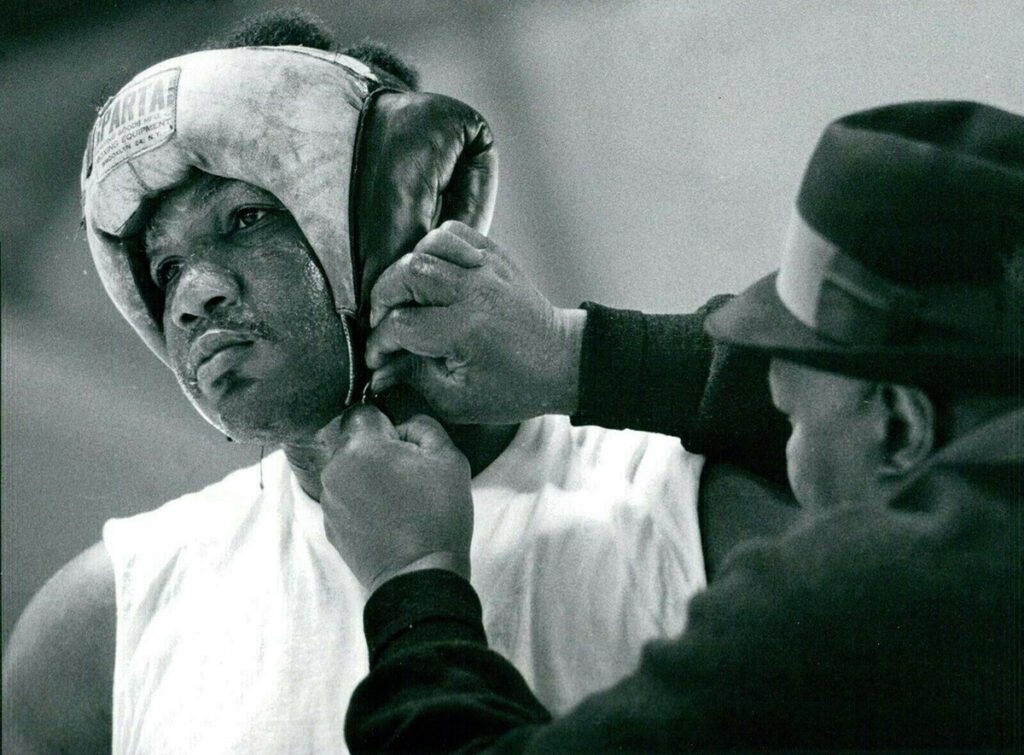
Just two years prior, the world had watched in disbelief as Muhammad Ali, against all odds, dethroned the seemingly invincible Foreman in the “Rumble in the Jungle.” That stunning defeat in Zaire had sent shockwaves through the boxing world and forced Foreman into a period of introspection and rebuilding.
His return to the ring in early 1976 saw him secure the NABF heavyweight title against Ron Lyle, a brutal affair that proved Foreman still possessed the raw power that had once terrified opponents but cast even further doubt about his invincibility. After the Lyle tussle, Foreman looked vulnerable and beatable.
The rematch with Joe Frazier, a man Foreman had demolished in just two rounds back in 1973 to claim his first world title, was a crucial step in Foreman’s quest to prove he was more than just a one-dimensional puncher.
Frazier, a former undisputed champion himself, was also looking to reclaim lost glory, albeit nearing the twilight of his illustrious career. Billed as the “Battle of the Gladiators,” it held significant weight for both men.
Promotional Hurdles and Long Island Logistics
While the fight itself promised fireworks, the road to getting Foreman and Frazier into the ring in Uniondale wasn’t without its bumps. Promoting a major heavyweight fight outside of the traditional boxing hubs like Las Vegas or New York City (Manhattan) presented its own set of challenges. Bringing two global boxing icons to Long Island required significant logistical planning, financial investment, and a little salesmanship.
The “Battle of the Gladiators” was announced on March 18 and was originally slated for the newly renovated Yankee Stadium, which had reopened after two years. That plan was upended by the Yankees’ mercurial owner, George Steinbrenner, who turned down the $150,000 rental fee, wanting to preserve the new grass and field.
“My groundskeepers say that June is the most dangerous time for grass. They want 16,000 seats all over the infield and outfield with plywood lying on it. Nothing can kill grass faster than plywood,” Steinbrenner told the Associated Press in 1976.
With the baseball playoffs looming, Yankee Stadium would host the third installment of Muhammad Ali v. Ken Norton in the early fall, with very little mention or concern for the grass.
Philadelphia and Houston were rejected as neither legend wanted to fight in the other’s hometown. Madison Square Garden would have been the next logical choice for promoter Jerry Perenchio, who promoted the “Fight of the Century” in the storied arena. The rental fee proved to be too high at $300,000.
Perenchio even considered renting the world’s largest tent and staging the event in Flushing at the World’s Fair Grounds. However, the construction of the tent would prove too costly and impractical because of the number of poles required.
Enter Jack Globenfelt, the Nassau Coliseum’s director of operations and bookings. He kept after Perenchio, imploring him to see the less than five-year-old venue. “I knew as soon as he came out to look, we could sell him,” said Globenfelt to the Associated Press in 1976. He did.
Perenchio was impressed with the venue, and the deal was struck at a rental fee of $50,000 for the event on June 15, 1976.
Nassau Coliseum Welcomes Foreman vs Frazier
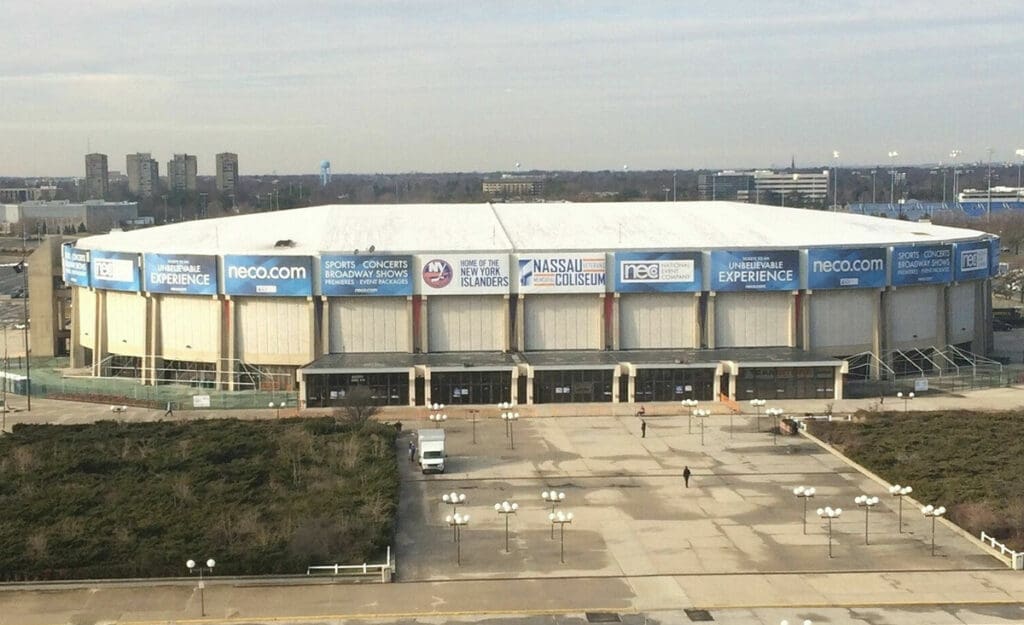
The Nassau Coliseum, while a large venue, wasn’t primarily designed for boxing. Transforming the arena to accommodate a world-class fight, including ring setup, lighting, and media accommodations, was a considerable undertaking.
Attracting a large enough audience to make the event financially viable was a key concern. While both Foreman and Frazier were big names, the rematch carried a different weight than their first encounter. Foreman was coming off his wild ride with Lyle, and Frazier had suffered defeat at the hands of Ali in the legendary “Thrilla in Manila.” The promotional team had to work diligently to build anticipation and convince fans that this was a must-see event.
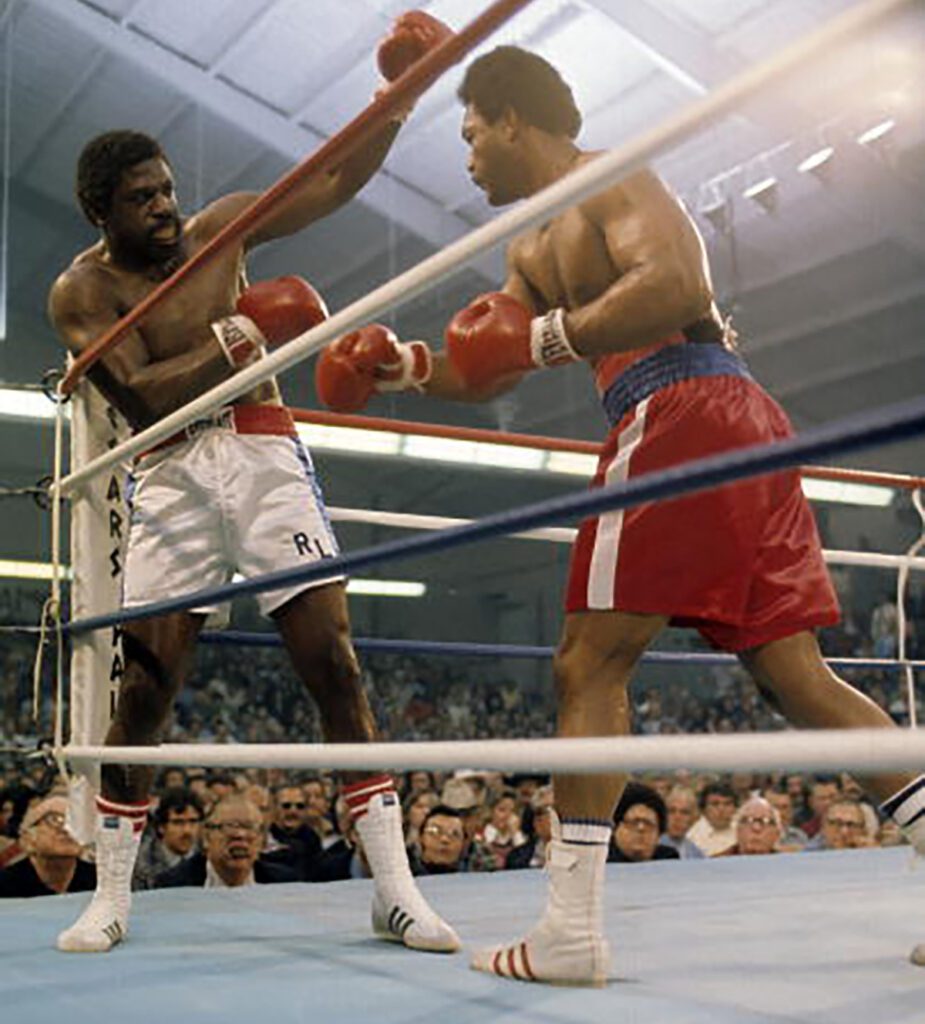
Local media played a crucial role in generating buzz. Newspapers and television stations on Long Island and in the wider New York metropolitan area highlighted the significance of hosting such a prominent sporting event. The arrival of Foreman in Uniondale became a local talking point, adding to the excitement.
Foreman rented a house on Hilton Avenue in Hempstead. Kids would ride their bikes by the house to catch a glimpse of the former champ. He worked out in the basement of the Nassau Coliseum, where a makeshift gym was set up. This was not the cheery hamburger hustling Foreman of the comeback years. It was the consistently late, dour student of Sonny Liston.
Despite that, he made the best of his time at the Coliseum, playfully working out in front of a local Long Island crowd, despite sometimes being over an hour late for his public sessions. He would shake hands with fans and lead them in chants of “Frazier, Frazier” to help motivate him.
Recent graduates of Nassau Community College came by after their ceremony earlier that day in the building to see the spectacle of Foreman denting a heavy bag or pummeling sparring partners.
Foreman even held a public workout in New York City, with a public sparring session in front of the Celanese Building on the Avenue of the Americas in Manhattan.
Battle of The Gladiators: Foreman and Frazier
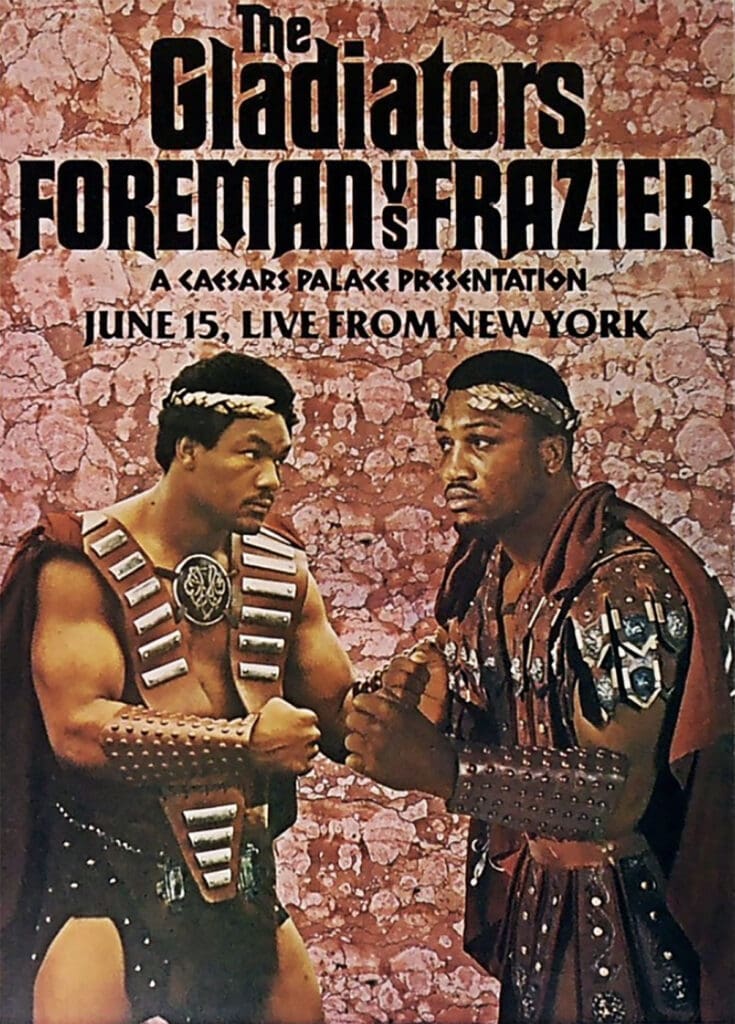
The crowd was a mix of seasoned boxing fans and curious locals, all eager to witness the clash of these two heavyweight titans. It would not be a sellout, drawing little more than half its capacity at 10,341.
Despite disappointing ticket figures, fight night arrived with a palpable energy in the Nassau Coliseum. Despite his best efforts to endear himself to the local crowd, Foreman played the heel that night entering to a chorus of boos.
The fight itself unfolded in a more measured way than their first encounter. Frazier, perhaps wary of Foreman’s early onslaught, adopted a more cautious approach. It was to no avail.
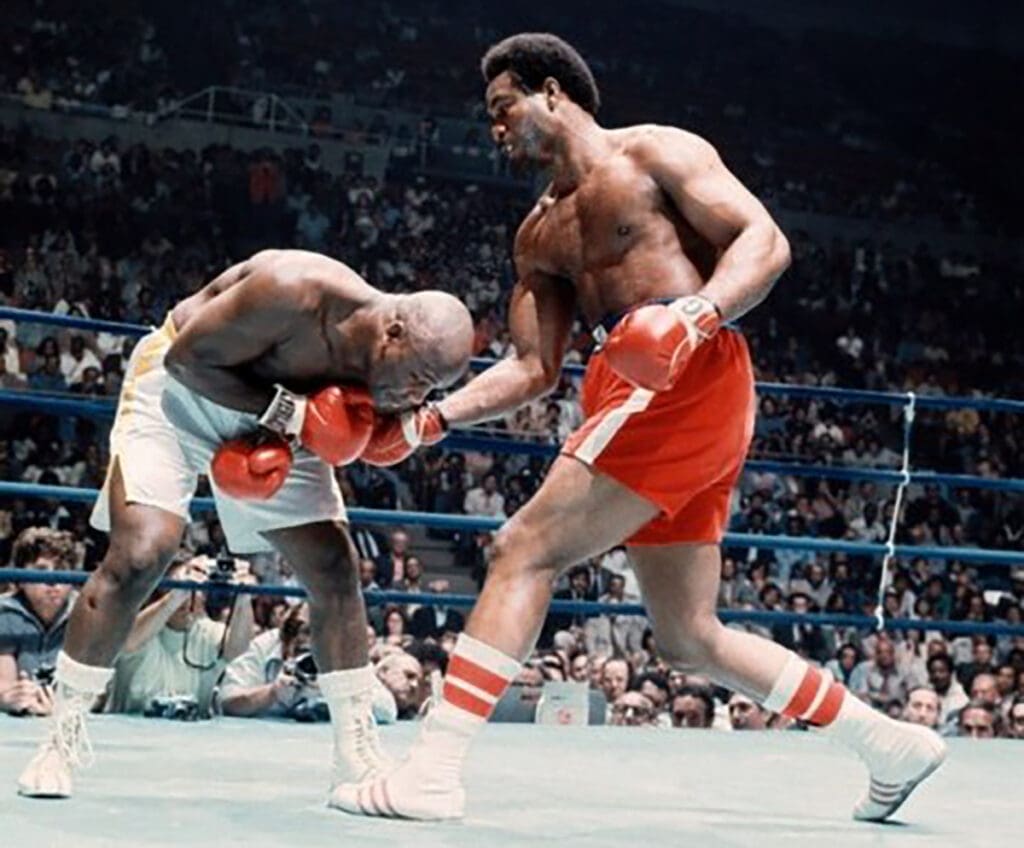
Foreman dominated from the opening bell and seemingly took a more patient and controlled approach. He began to assert his dominance as the rounds progressed and survived Frazier’s devastating left hook. His powerful jab, which commentator Howard Cosell said, looked like a “telephone pole” kept Frazier at bay, and his thudding punches began to take their toll.
By the fifth round, Foreman’s relentless pressure proved too much. A devastating combination of murderous rights and lefts sent Frazier crashing down to the canvas. The warrior in Frazier rose, but another brutal right hand put him down for good in the corner. Despite Frazier’s legendary toughness, his trainer Eddie Futch, seeing the punishment his fighter was absorbing, made the courageous decision to step in and stop the fight.
George Foreman had secured a decisive victory, his second over Joe Frazier. That night in Uniondale, Long Island witnessed Foreman’s powerful resurgence, a statement to the boxing world that he was far from finished.
See Foreman vs Frazier II here.
While his journey back to the world title would take almost 20 years, including a ten-year sojourn and one of the most storied comebacks in boxing, this victory against a formidable opponent on Long Island served as notice that he was back.
While ticket sales were disappointing, it was still a lucrative night for Long Island. The “Battle of the Gladiators” pumped roughly $2.5 million into the local economy, between the hotels, restaurants, parking, and concessions.
“The Night George Foreman Came to Town” wasn’t just about a boxing match. It was about a fighter’s determination, a region stepping into the sporting world’s spotlight, and a reminder of the raw power and drama that only heavyweight boxing can deliver.
For the fans in the Nassau Coliseum that night, it was an unforgettable chapter in the rich history of the sweet science, forever linked to the name of George Foreman and the unlikely stage of Uniondale, Long Island.
